Space pictures! See our space image of the day
Martian Spiders!
Space can be a wondrous place, and we've got the pictures to prove it! Take a look at our favorite space pictures here, and if you're wondering what happened to today in space history don't miss our On This Day in Space video show here!
Martian Spiders!
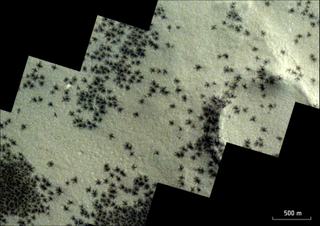
Monday, April 29, 2024: Seasonal, spider-like features have been spotted sprouting through cracks in Mars' surface.
The European Space Agency's Mars Express orbiter captured new images of small, dark features that resemble spiders scuttling across the Martian region known as Inca City near the Red Planet's south pole.
This phenomenon appears when spring sunlight warms layers of carbon dioxide deposited during the dark Martian winter. In turn, carbon dioxide ice in the bottom layer turns into gas, which builds up and eventually breaks through overlying ice up to 3.3 feet (1 meter) thick, according to a statement from ESA. — Samantha Mathewson
Related: Strange cluster of 'spiders' spotted in 'Inca City' on Mars
Boeing Starliner astronauts arrive in style
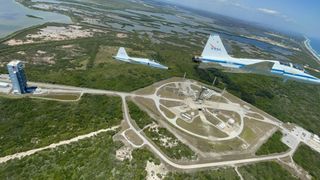
Friday, April 26, 2024: NASA astronauts know how to make an entrance.
On Thursday (April 26), the astronauts flying on the upcoming 1st crewed test flight of Boeing's Starliner spacecraft arrived at Kennedy Space Center in Florida in NASA T-38 jets. The flight is set for May 6.
Get the Space.com Newsletter
Breaking space news, the latest updates on rocket launches, skywatching events and more!
Mike Fincke, who is set to fly on the next Starliner mission should the flight test go well, flew in along with the crew and posted a picture of the arrival to X (formerly Twitter).
"I had the privilege of flying with the Starliner prime crew to our launch pad today in our amazing T-38 training aircraft. You can see pad 41 and the ULA's Vertical Integration Facility where the mighty Atlas V and Boeing's Starliner await launch. Go Atlas. Go Centaur. Go Starliner. May 6th," Fincke wrote in the post on X.
Cosmonauts spacewalk outside the ISS
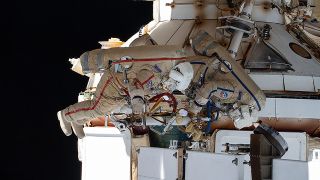
Thursday, April 25, 2024: In this image, Russian cosmonauts Oleg Kononenko and Nikolai Chub conduct a spacewalk outside the International Space Station on April 25, 2024.
The two spacewalkers will configure hardware and install experiments on the Russian segment of the ISS during their seven-hour extravehicular activity (EVA), the technical term for a spacewalk.
Related: Watch 2 cosmonauts conduct spacewalk outside the ISS today
'Doomed' comet photobombs 2024 solar eclipse
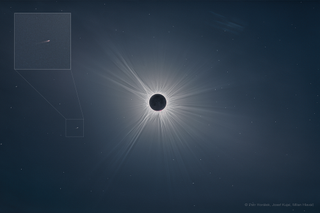
Wednesday, April 24, 2024: A 'doomed' comet photobombed the sun during the total solar eclipse on April 8, 2024.
The image caught the comet, designated Comet SOHO-5008, as it sped towards its demise. The comet was discovered only hours prior to the eclipse in images from ESA's and NASA's sun-watching Solar and Heliospheric Observatory (SOHO). The U.S. Naval Research Laboratory's Karl Battams, manager of the SOHO Sungrazer Project that searches for comets in SOHO imagery, correctly predicted that the comet would be visible during the eclipse.
The comet disintegrated soon after the photograph was taken, breaking up as it neared the sun.
Read more: Solar spacecraft 'SOHO' discovers its 5,000th comet
Hubble peers into the Little Dumbbell Nebula
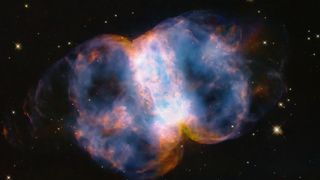
Tuesday, April 23, 2024: On the 34th anniversary of the Hubble Space Telescope, the iconic observatory released a colorful image of the Little Dumbbell Nebula, also known as Messier 76 or M76.
This nebula, located 3,400 light-years away in the Perseus constellation, is named after its double-lobed shape that resembles a dumbbell or hourglass.
M76 is a planetary nebula, meaning it's an expanding shell of gas around an aging or dying star. It is one of only four planetary nebulas in the famous Messier catalog of astronomical objects.
Related: Photographer Spies Little Dumbbell Nebula in a Sea of Stars
Space debris crashes into Florida home
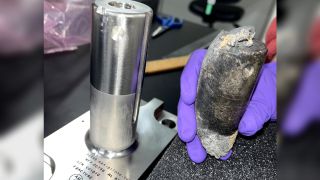
Monday, April 22, 2024: NASA confirmed that an object that crashed through the roof of a Florida home in March was a piece of space junk tossed overboard from the International Space Station (ISS).
The object ended up being part of a cargo pallet that was loaded with 5,800 pounds (2,630 kilograms) of dead batteries and jettisoned from the ISS in March 2021.
"Based on the examination, the agency determined the debris to be a stanchion from the NASA flight support equipment used to mount the batteries on the cargo pallet," agency officials wrote in an update on April 15.
The cylindrical piece of space junk is made of a metallic alloy called Inconel weighing 1.6 pounds (0.7 kg) and measuring 4 inches (10 centimeters) high by 1.6 inches (4 cm) wide.
Related: Object that slammed into Florida home was indeed space junk from ISS, NASA confirms
NASA pilot gets inverted
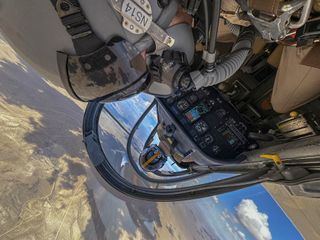
Friday, April 19, 2024: While NASA is most known for its space exploration, the first 'A' in the agency's acronym, aeronautics, is a reminder that NASA also pioneers a great deal of aviation innovation.
In this photo, NASA research pilot David Nils Larson and photographer Jim Ross can be seen conducting an inverted aerobatic maneuver in a T-34C aircraft owned by the agency's Armstrong Flight Research Center in Edwards, California during a proficiency flight.
Aside from apparently being a big enough Pittsburgh Steelers fan to wear one of the team's helmets during this flight, Larson serves as NASA's lead pilot for the revolutionary X-59 jet. The X-59 program aims to re-open the door on commercial supersonic flight by demonstrating that aircraft can be designed to break the sound barrier without producing the deafening sonic booms typically associated with flying faster than the speed of sound.
Related: NASA is 'learning to listen to the X-59' by simulating sonic thumps with fighter jets (photos)
Starliner on the move with Williams and Wilmore
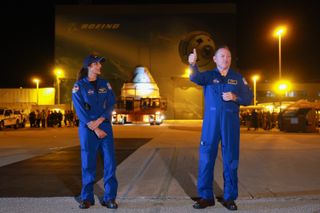
Tuesday, April 16, 2024: Early this morning, Boeing rolled their Starliner space capsule from the commercial crew and cargo processing facility at NASA's Kennedy Space Center (KSC), to the spacecraft's Atlas V rocket launch vehicle at United Launch Alliance's (ULA's) vertical integration facility 6 miles (10 kilometers) away.
Starliner faces its first crewed launch in the coming weeks, and Crew Flight Test NASA astronauts Suni Williams and Butch Wilmore were present for the spacecraft's rollout early Tuesday.
Looking back at the eclipse
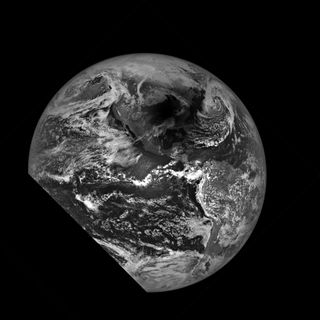
Monday, April 15, 2024: A whole week has passed since the total solar eclipse swept across North America, and many of us are still processing getting to witness the amazing celestial alignment. In this photo, the shadow of the moon on the face of the Earth can be seen from over a hundred-thousand miles away, by NASA's Lunar Reconnaissance Orbiter (LRO).
LRO, which orbits the moon, is customarily used to image and study the lunar surface. LRO launched on June 18, 2009, and arrived in lunar orbit five days later. Its mission was originally intended to last just two years, with the goal of 3D mapping of the moon's surface. However, the probe is still in operation, now 15 years later. Now, NASA has tasked LRO with supporting the Artemis program by focusing the probe on the moon's poles to search for water or ice thought to exist there.
Behold, the chromosphere!
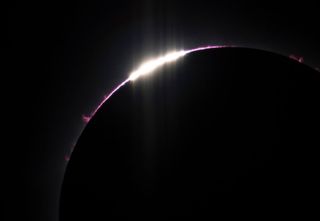
Friday, April 12, 2024: The last of our solar eclipse image round-up for eclipse week! The moon passes in front of the sun in Bloomington, Indiana, in this picture from photojournalist Jeremy Hogan. The solar eclipse, which was seen from Mexico, the United States, and Canada, was the first one to pass over the American state of Indiana since 1869.
The solar eclipse reveals aspects of the sun that are usually obscured. This image shows the pink layer of the sun's chromosphere around the dark disk of the moon during totality.
Vanish the clouds
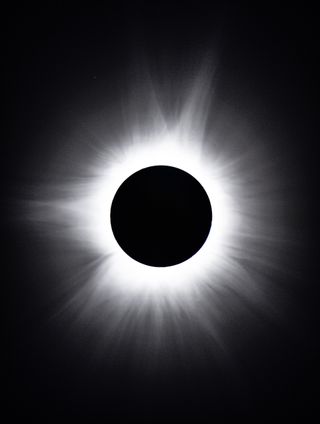
Thursday, April 11, 2024: The solar eclipse looks particularly fierce in a "miracle" image taken from Kimball Bend Park in Central Texas by Space.com reader Justin Maune. They said, "I just took this photo a few hours ago. I traveled 30 hours from So Cal to Texas to see this.
"The clouds were looking terrible. Overcast. And then it cleared. Like a miracle, 10 minutes before totality, the sky was clear, and I was able to snap this pic."
Eclipse Across America
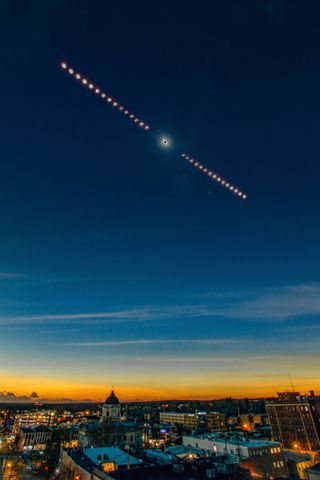
Wednesday, April 10, 2024: The total solar eclipse was one of the most-watched eclipses ever. All of North America and Central America experienced a partial solar eclipse, but only those located within the path of totality — an approximately 115-mile (185-kilometer) wide and 10,000-mile-long (16,000 kilometers) route — saw the moon completely obscure the sun.
The path of totality crossed four states in Mexico (Sinaloa, Nayarit, Durango and Coahuila) before sweeping over 15 U.S. states (Texas, Oklahoma, Arkansas, Missouri, Illinois, Kentucky, Tennessee, Michigan, Indiana, Ohio, Pennsylvania, New York, Vermont, New Hampshire, and Maine) and seven Canadian Provinces (Ontario, Quebec, New Brunswick, Prince Edward Island, Nova Scotia and Newfoundland).
Pictured above, Bloomington, Indiana, enjoyed clear skies Monday, gifting onlookers a full 2.5 hours as the moon began and ended its full transit in front of the sun.
About yesterday...
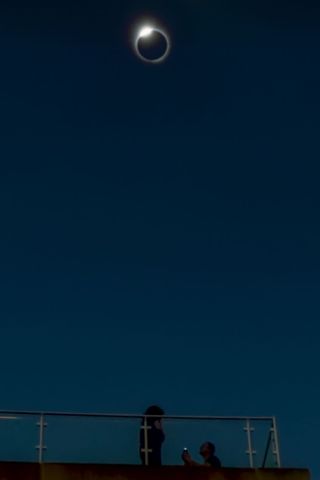
Tuesday, April 9, 2024: Yesterday, in Bloomington, Indiana, as the solar eclipse slipped into the diamond ring effect just before totality, Space.com's Josh Dinner proposed to his fiancée, and she said, "Yes!"
The total solar eclipse swept across North America yesterday, making way for millions to view the rare celestial alignment. We hope you were able to make your way to the path of totality. The next total solar eclipse in the United States won't occur until 2045!
The Sun!
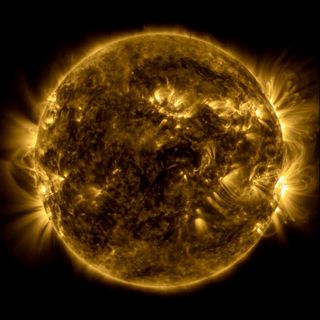
Monday, April 8, 2024: It's the sun! Today, for many across North America, the sun will be blocked out for up to four and a half minutes, as the shadow from the moon passes across the face of the Earth.
Solar eclipses aren't entirely uncommon, but the occurrence of one over such a populated swath of land is seldom seen. The next major total solar eclipse to cross the United States won't come around until 2045.
Super Heavy gettin' ready
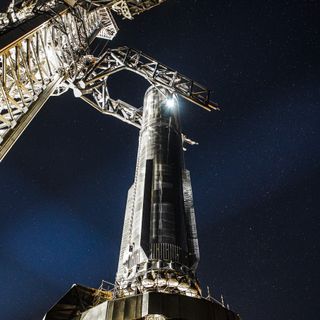
Friday, April 5, 2024: Super Heavy is presumably being positioned for a static fire, a prelaunch test in which the booster's 33 Raptor engines will burn for a few seconds while the vehicle remains anchored to the pad.
SpaceX has already performed static fires with the booster's partner — a 165-foot-tall (50-meter-tall) upper-stage spacecraft that will fly with this Super Heavy on the fourth Starship test flight.
That mission could launch as soon as as soon as early May, SpaceX President and Chief Operating Officer Gwynne Shotwell said last month. — Mike Wall
A comet during the eclipse?
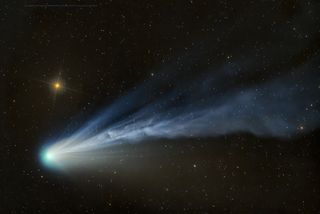
An unusual "horned" comet is now visible in the night sky — and it may even make a rare appearance during the 2024 total solar eclipse on April 8. Comet 12P/Pons-Brooks can currently be seen in the night skies of the northern hemisphere. Comets, composed of dust, rock and ices, heat up and expel gas when their orbits bring them closer to the sun, creating a glowing halo around the comet itself known as a coma. Outbursts observed from Comet 12P give it a horned-like appearance, earning it nicknames such as "Devil Comet" and "Millennium Falcon." — Samantha Mathewson
Like fireworks in space!

Wednesday, April 3, 2024: NASA's astronomy photo of the day for today comes to us from over 450 light-years away. According to NASA, the Pa 30 nebula resembles planetary nebulas, or other nebulas formed from nova. However, scientists believe Pa 30 may have formed after two white dwarf stars entered into a spiral together, eventually merging. Because of this, Pa 30 is also referred to as SN 1181 (SN for supernova). The blue star in the center is though to be the "zombie star" remnant of the white dwarf collision.
This image was captured using data from multiple telescopes. NASA's Wide-field Infrared Survey Explorer (WISE), the Hiltner 2.4-meter Telescope at MDM Observatory, Pan-STARRS, the Chandra X-Ray Observatory and ESA's XMM-Newton telescope were all used to combine infrared, visible and X-ray light spectra.
Astronaut afloat
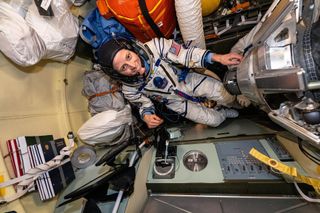
Tuesday, April 2, 2024: NASA astronaut Loral O'Hara conducts leak checks aboard a Russian module of the International Space Station (ISS). O'Hara launched to the ISS in September, 2023, riding the MS-24 Soyuz capsule with cosmonauts Oleg Kononenko and Nikolai Chub.
O'Hara recently donned the Sokol IVA suit she will wear during MS-24's return to Earth. She is seen here wearing the suit while performing leak checks in one of the station's Roscosmos modules. While living and working aboard the orbital laboratory, O'Hara is serving as Expedition 70 Flight Engineer. Her, Kononenko and Chub are expected to scheduled to complete their crew rotation and return aboard their Soyuz capsule April 6.
One week until the total solar eclipse!
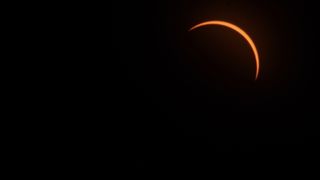
Monday, April 1, 2024: We are one week away from the United States' last total solar eclipse until 2044! With only seven days to go until the April 8 eclipse, we are almost there. In this photo, the sun and moon are almost there, too. This image was captured during the 2017 total solar eclipse, in the moments leading up to totality. Just like the moon covering the sun in this photo, the U.S. is inching toward a solar eclipse that will, quite literally, sweep across the nation, putting millions in the moon's shadow and the path of totality, which will last nearly 4.5 minutes.
Related: Total solar eclipse 2024: Live updates
Archives
Check out our Image of the Day Archives for more awesome photos.
Image of the Day 2020 Archive

Image of the Day 2019 Archive
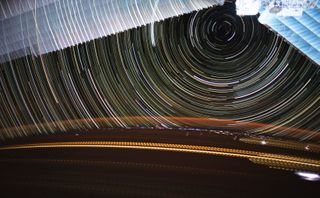
Can't find the date you're looking for? It may have been a weekend or holiday, when we don't normally update our Image of the Day.
Click 'NEXT PAGE' below for March >
Join our Space Forums to keep talking space on the latest missions, night sky and more! And if you have a news tip, correction or comment, let us know at: community@space.com.

Space.com is the premier source of space exploration, innovation and astronomy news, chronicling (and celebrating) humanity's ongoing expansion across the final frontier. Originally founded in 1999, Space.com is, and always has been, the passion of writers and editors who are space fans and also trained journalists. Our current news team consists of Editor-in-Chief Tariq Malik; Editor Hanneke Weitering, Senior Space Writer Mike Wall; Senior Writer Meghan Bartels; Senior Writer Chelsea Gohd, Senior Writer Tereza Pultarova and Staff Writer Alexander Cox, focusing on e-commerce. Senior Producer Steve Spaleta oversees our space videos, with Diana Whitcroft as our Social Media Editor.
-
rod ReplyThe Exoplanets Channel said:The images are truly breath-taking.
The Exoplanets Channel, what star and reddish exoplanet is shown in your picture, looks like about 8" angular separation? I use this site as my canonical reference to exoplanets, The Extrasolar Planets Encyclopaedia Currently 4150 exoplanets are listed. -
swiggly ReplyThe Exoplanets Channel said:The images are truly breath-taking.
My Comet Image:
Neowise -
rod Reply
This is a very good image here. In enjoyed some recent views of NEOWISE using my 90-mm telescope at 40x early, shortly after 0415 EDT. Bifurcated tail obvious too.swiggly said:My Comet Image:
Neowise -
Helio The IOD image for yesterday of the Veil nebula is stunning! The graphics are such that it's almost as if it has an oil film on top. It has both 3D and texture feel to it.Reply -
Astro.Letizia I hope they start posting these daily again! I always start my day off with the newest image but it's been a couple of months now :(Reply
